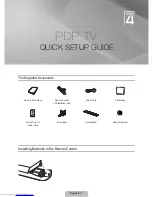
Service Modes, Error Codes, and Fault Finding
EN 21
EBJ1.0U
5.
Basically there are three kinds of errors:
•
Errors detected by the Stand-by Processor.
These
errors will always lead to protection and an automatic start
of the blinking LED for the concerned error (see paragraph
“The Blinking LED Procedure”). In these cases SDM can
be used to start up (see chapter “Stepwise Start-up”).
•
Errors detected by VIPER that lead to protection.
In this
case the TV will go to protection and the front LED will blink
at 3 Hz. Further diagnosis via service modes is not possible
here (see also paragraph “Error Codes” -> “Error Buffer” -
> “Extra Info”).
•
Errors detected by VIPER that do not lead to
protection.
In this case the error can be read out via
ComPair, via blinking LED method, or in case you have
picture, via SAM.
5.4.2
How to Read the Error Buffer
Use one of the following methods:
•
On screen via the SAM (only if you have a picture). E.g.:
–
00 00 00 00 00
: No errors detected
–
06 00 00 00 00
: Error code 6 is the last and only
detected error
–
09 06 00 00 00
: Error code 6 was first detected and
error code 9 is the last detected error
•
Via the blinking LED procedure (when you have no
picture). See next paragraph.
•
Via ComPair.
5.4.3
How to Clear the Error Buffer
Use one of the following methods:
•
By activation of the “RESET ERROR BUFFER” command
in the SAM menu.
•
With a normal RC, key in sequence “MUTE” followed by
“062599” and “OK”.
•
If the content of the error buffer has not changed for 50+
hours, it resets automatically.
5.4.4
Error Buffer
In case of non-intermittent faults, clear the error buffer before
you begin the repair (
before
clearing the buffer, write down the
content, as this history can give you significant information).
This to ensure that old error codes are no longer present.
If possible, check the entire contents of the error buffer. In
some situations, an error code is only the result of another error
code and not the actual cause (e.g., a fault in the protection
detection circuitry can also lead to a protection).
There are several mechanisms of error detection:
•
Via error bits in the status registers of ICs.
•
Via polling on I/O pins going to the stand-by processor.
•
Via sensing of analogue values on the stand-by processor.
•
Via a “not acknowledge” of an I
2
C communication
Take notice that some errors need more than 90 seconds
before they start blinking. So in case of problems wait 2
minutes from start-up onwards, and then check if the front LED
is blinking.
Table 5-3 Error code overview
Error
Description
Monitored by
Error/Prot
Device
Defective Module
schematics ID
1
I2C1
Viper
P
i2c1_blocked
2
I2C2
Viper
P
i2c2_blocked
3
I2C3 (connect SDA line to GND)
St-by µP
P
i2c3_blocked
B05E/B05A
4
I2C4
Viper
P
i2c4_blocked
5
Viper - Severe HW problem
St-by µP
P
PNX8550
control
B01B/B05A
6
5V supply
St-by µP
P
5v_supply
B04E
7
8V6 supply
St-by µP
P
8v_supply
8
1.2V DC/DC
St-by µP
P
1v2_supply
B04E
9
2.5V DC/DC
St-by µP
P
2v5_supply
11
3.3V DC/DC
St-by µP
P
3v3_supply
B04E
12
12V supply
St-by µP
P
12v_supply
B04E
13
Audio supply
St-by µP
P
audio_supply
14
Class D amplifiers
St-by µP
P
class_d_supply
B08A
16
MPIF1 main supply (MSUP)
Viper
E
KN10241C
if_io
17
MPIF1 audio supply (ASUP)
Viper
E
KN10241C
if_io
B03D
18
MPIF1 ref freq (ROK)
Viper
E
KN10241C
if_io
B03B
21
MPIF2 main supply (MSUP)
Viper
E
KN10241C
if_io2
22
MPIF2 audio supply (ASUP)
Viper
E
KN10241C
if_io2
23
MPIF2 ref freq (ROK)
Viper
E
KN10241C
if_io2
25
Supply fault
St-by µP
P
dc_dc_supply
B01A
26
Power Dip detected
St-by µP
E
[2]
27
Phoenix
Viper
E
PNX2015B
hd_subsystem
B04E
28
MOP
Viper
P
EP1C6
ouput_processor
28
JOP
Viper
P
EP1C6
ouput_processor
29
AVIP1
Viper
E
PNX3000
av_input_processor1
B04E
31
AVIP2
Viper
E
PNX3000
av_input_processor2
32
MPIF1
Viper
E
KN10241C
anl_fr_1
B03B
33
MPIF2
Viper
E
KN10241C
anl_fr_2
34
Tuner1
Viper
E UV1318/TEDH700A
tuner1
B02B
35
Tuner2
Viper
E UV1318/TEDH700A
tuner2
36
OFDM
Viper
E
TDA10046
digital_if
37
Channel decoder
Viper
E
NXT2003
Channel decoder 1
B02A
38
I/O expander audio
Viper
E
PCA9555
audio_io_expander
39
POD Interface
Viper
E
STV701
POD Interface
41
Channel decoder
Viper
E
NXT2004
Channel decoder 2
42
audio source select matrix
Viper
E
TEA6422
audio_source_select
43
Hi Rate Front End
Viper
E
TDA8751
hdmi
B07B
44
main NVM
Viper
E
M24C32
nvm
B05E
45
Columbus 1
Viper
E
T6TU5XB-0001
comb_filter
B04E
46
Pacific 3
Viper
E
t.b.d.
pq_fpga
Содержание EBJ1.0U
Страница 66: ...66 EBJ1 0U 7 Circuit Diagrams and PWB Layouts Layout SSB Top Side Part 1 G_16290_129a eps 130206 Part 1 ...
Страница 67: ...Circuit Diagrams and PWB Layouts 67 EBJ1 0U 7 Layout SSB Top Side Part 2 G_16290_129b eps 130206 Part 2 ...
Страница 69: ...Circuit Diagrams and PWB Layouts 69 EBJ1 0U 7 Layout SSB Bottom Side Part 1 Part 1 G_16290_130a eps 130206 ...
Страница 70: ...70 EBJ1 0U 7 Circuit Diagrams and PWB Layouts Layout SSB Bottom Side Part 2 Part 2 G_16290_130b eps 130206 ...
Страница 102: ...102 EBJ1 0U 7 Circuit Diagrams and PWB Layouts Layout SSB Top Side Part 1 Part 1 G_15861_030a eps 210606 ...
Страница 103: ...Circuit Diagrams and PWB Layouts 103 EBJ1 0U 7 Layout SSB Top Side Part 2 Part 2 G_15861_030b eps 210606 ...
Страница 105: ...Circuit Diagrams and PWB Layouts 105 EBJ1 0U 7 Layout SSB Bottom Side Part 1 Part 1 G_15861_031b eps 210606 ...
Страница 106: ...106 EBJ1 0U 7 Circuit Diagrams and PWB Layouts Layout SSB Bottom Side Part 2 Part 2 G_15861_031b eps 210606 ...
Страница 166: ...Revision List EN 166 EBJ1 0U 11 ...
















































